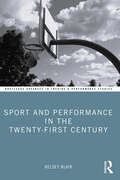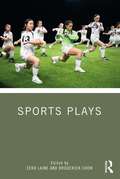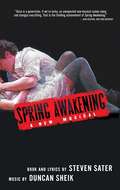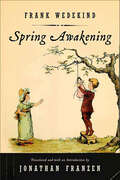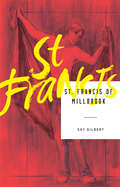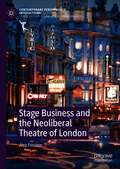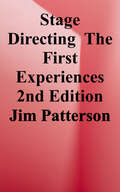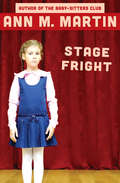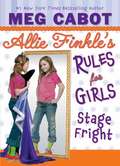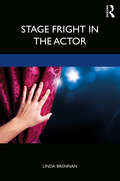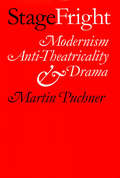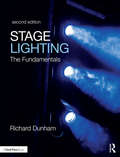- Table View
- List View
Sport and Performance in the Twenty-First Century (Routledge Advances in Theatre & Performance Studies)
by Kelsey BlairAnalyzing sport through the lens of performance and theorizing performance through the lens of sport, Sport and Performance in the Twenty-First Century offers a field intervention, a series of in-depth performance analyses, and an investigation of the intersection between sport performances and public life in the historical present in the global north. The objectives of this book are three-fold. First, the book advocates for the study of sport in the fields of Theatre and Performance Studies and, through in-depth performance analyses, demonstrates how the critical language and methods of performance studies help illuminate the manifold impacts of the practices, activities, and events of sport. Second, the book introduces new critical language that was originally developed in conjunction with sport but is also designed for cross-genre performance analysis. In introducing novel terminology, the book aims to simultaneously facilitate analysis of sport performances and to demonstrate how the study of sport can contribute to the fields of Theatre and Performance Studies. Finally, the book investigates the epistemological, affective, and socio-political effects of sport performances in order to illuminate how sport performances influence, and are influenced by, their historical conditions. This study will be of great interest to students and scholars in Theatre and Performance Studies, Physical Culture Studies, and Socio-Cultural Sports Studies.
Sporting Performances: Politics in Play
by Shannon L. WalshSporting Performances is the first anthology to tackle sports and physical culture from a performance perspective; it serves as an invitation and provocation for scholarly discourse on the connections between sports and physical culture, and theatre and performance. Through a series of intriguing case studies that blur the lines between the realms of politics, sports, physical culture, and performance, this book assumes that sporting performances, much like theatre, serve as barometers, mirrors, and refractors of the culture in which they are enmeshed. Some of the topics include nineteenth-century variety show pugilists, athletes on Broadway, sumo wrestlers, rhythmic gymnasts, and Strava enthusiasts. While analyzing sport through the lens of theatre and performance, this anthology reflects on how physical culture and sports contribute to identity formation and the effects of nuanced imprints of physical activity on the mind, soul, and tongue. Written primarily for those interested in physical fitness, sports, dance, and physical theatre, this interdisciplinary volume is a crucial tool for Performance and Theatre Studies students and those in the fields of Sports Studies, Cultural Studies, Women’s and Gender Studies, and American Studies more broadly.
Sports Plays
by Sports PlaysSports Plays is a volume about sports in the theatre and what it means to stage sports. The chapters in this volume examine sports plays through a range of critical and theoretical approaches that highlight central concerns and questions both for sports and for theatre. The plays cut across boundaries and genres, from Broadway-style musicals to dramas to experimental and developmental work. The chapters examine and trouble the conventions of staging sports as they open possibilities for considering larger social and cultural issues and debates. This broad range of perspectives make the volume a compelling resource for students and scholars of sport, theatre, and performance studies whose interests span feminism, sexuality, politics, and race.
Spring Awakening
by Steven Sater Duncan Sheik"This brave new musical, haunting and electrifying by turns, restores the mystery, the thrill to that shattering transformation that stirs in all our souls."--Charles Isherwood, The New York Times"The staggering purity of this show will touch all open hearts...In its refined, imaginative simplicity, it daringly reverses all the conventional rules by returning the American musical to an original state of innocence."--John Heilpern, The New York Observer"An unexpected jolt of sudden genius, edgy in its brutally honest, unromanticized depiction of human sexuality."--New York Post Spring Awakening is an extraordinary new rock musical with book and lyrics by Steven Sater and music by Grammy Award-nominated recording artist Duncan Sheik. Inspired by Frank Wedekind's controversial 1891 play about teenage sexuality and society's efforts to control it, the piece seamlessly merges past and present, underscoring the timelessness of adolescent angst and the universality of human passion. Steven Sater's plays include the long-running Carbondale Dreams, Perfect for You, Doll (Rosenthal Prize/Cincinnati Playhouse), Umbrage (Steppenwolf New Play Prize), and a reconceived version of Shakespeare's Tempest, which played in London. Duncan Sheik is a singer/songwriter who also collaborated with Sater on the musical The Nightingale. He has composed original music for The Gold Rooms of Nero and for The Public Theater's Twelfth Night in Central Park.
Spring Awakening: A Play
by Frank WedekindFrom Jonathan Franzen, bestselling author of The Corrections and Crossroads, comes his razor-sharp translation of Frank Wedekind's major modern play, Spring Awakening.Featuring an introduction by Franzen.First performed in Germany in 1906, Frank Wedekind's controversial play Spring Awakening closed after one night in New York in 1917 amid charges of obscenity and public outrage. For the better part of the twentieth century Wedekind's intense body of work was largely unpublished and rarely performed. Yet the play's subject matter—teenage desire, suicide, abortion, and homosexuality—is as explosive and important today as it was a century ago. Spring Awakening follows the lives of three teenagers, Melchior, Moritz, and Wendl, as they navigate their entry into sexual awareness. Unlike so many works that claim to tell the truth of adolescence, Spring Awakening offers no easy answers or redemption.Today, more than a hundred years after the play's first performance, a new musical version of this essential modern masterpiece is being hailed as the "best new musical . . . in a generation" (John Heilpern, The New York Observer). Franzen's rendition of the text—for so long poorly served in English—is unique in capturing the bizarre and inimitable comic spirit that animates almost every line of this unrelentingly tragic play. There couldn't be a better time for this thrilling, definitive new translation.
Spring Storm
by Tennessee Williams Dan Isaac"A crucible of so many elements that would later shape and characterize Williams's work."--World Literature Today When Tennessee Williams read Spring Storm aloud to his playwriting class at the University of Iowa in 1938, he was met with silence and embarrassment. His professor, the renowned E. C. Mabie, remarked as he got up and dismissed the seminar, "Well, we all have to paint our nudes!" Tom's earlier comment in his journal that the play "is well-constructed, no social propaganda, and is suitable for the commercial stage" seems accurate enough in 1999, but woefully naive deep in the Depression when the play's sexual explicitness--particularly its matter-of-fact acceptance of a woman's right to her own sexuality--would have been seen as not only shocking but also politically radical. Spring Storm would later be disavowed by the author as "simply a study of Sex--a blind animal urge or force (like the regenerative force of April) gripping four lives and leading them into a tangle of cruel and ugly relations." But the solid and deft characterizations of the four young people whose lives intertwine--the sexually alive Heavenly Critchfield, her earthy lover Dick Miles, Heavenly's wealthy but tongue-tied admirer Arthur Shannon, and the repressed librarian Hertha Nielson who loves Arthur--are archetypes of characters we will meet again and again in the Williams canon. Epic in scope, a bit melodramatic in execution, tragic in outcome, Spring Storm created a wave of excitement among theatre insiders when it was given a staged reading at The Ensemble Studio Theatre's Octoberfest '96. This edition has been prepared, with an illuminating introduction, by Dan Isaac, who initiated the Octoberfest production.
Square Root of Love (Off-off Broadway Festival Plays Ser.)
by Daniel Meltzer4 Simple Interiors / This full length evening portrays four preludes to love from youth to old age, from innocence to maturity. It is best when played by a single actor and actress. In The Square Root of Love, two genius level college students discover that Man or Woman does not live by intellectual pursuits alone. A Good Time for a Change finds a successful executive and her handsome young male secretary ready to make a change. The Battling Brinkmires are George and Marsha Brinkmire, a middle aged couple who have come to Haiti to get a "quickie" divorce. This one has a surprise ending. In Waiting for to Go, we are on a jet waiting to take off for Florida. He's a retired plumbing contractor who thinks his life is over she's a recent widow returning to her home in Hallandale. The play, and the evening ends with a beginning. This Off Off Broadway success requires only minimal settings.
Squawk
by Megan Gail ColesAnnie Runningbird doesn’t have time for the games boys want her to play. She’s aging out of foster care on her next birthday. The system has decided she is an adult, so Annie must make adult decisions. Where will she live? How will she make money? Demanding grown-up choices preoccupy the young girl’s mind as she navigates relationships with boys and men in her company. Does she like Isaac, a cute yet naive boy she met at the mall food court? Can she trust Louis, her older and increasingly overbearing foster care worker? Who can Annie depend on in her ever-shifting world? This intel is important. Because Annie needs to win the very real game she’s playing. She must save herself to save the day.
Squirrel on Stage (Twitch the Squirrel)
by Vivian Vande VeldeTwitch the lovably chaotic squirrel and Sweetie the Library Rat accidentally make their stage debuts in this hilarious chapter book, a new followup to 8 Class Pets.When Twitch discovers the kids at school are putting on a Cinderella play, he can&’t believe his luck. He loves good stories! But how to watch the play undetected? He convinces friend Sweetie the library rat to join his adventure to the auditorium, but of course it doesn&’t go as planned! Twitch and Sweetie will go behind the curtain and even above stage before the day is over in this fourth book in the celebrated series.With energetic illustrations accompanying the short, hilarious chapters, told from Twitch and Sweetie&’s alternating points of view, Squirrel on Stage is a perfect pick for young readers just starting to seek out longer texts—or a great read-aloud. For aspiring thespians, Squirrel on Stage also includes tips kids can use to put on their own play.
St George and the Dragon (The Faerie Queene #Book 1)
by Edmund SpenserThis vibrant new prose version faithfully adheres to the story of St George and the Dragon, and captures Spenser's rich language, tone and vigor. It strikes a skillful balance between faithfulness and fluency, without omitting or dumping down any details. It is Spenser's The Faerie Queene, Book One, in its entirety.
St. Francis of Millbrook
by Sky GilbertBeing a teenager is hard, especially if you're questioning your sexuality and growing up in rural Ontario in the mid '90s. Add to that a temperamental, homophobic father and a tenacious love for Madonna, and it's almost unbearable. Despite it all, Luke loves working on the family farm, and at least he has the support of a group of local outsiders who invite him into their circle.
Stage Business and the Neoliberal Theatre of London (Contemporary Performance InterActions)
by Alex FerroneThis book examines contemporary English drama and its relation to the neoliberal consensus that has dominated British policy since 1979. The London stage has emerged as a key site in Britain’s reckoning with neoliberalism. On one hand, many playwrights have denounced the acquisitive values of unfettered global capitalism; on the other, plays have more readily revealed themselves as products of the very market economy they critique, their production histories and formal innovations uncomfortably reproducing the strategies and practices of neoliberal labour markets. Stage Business and the Neoliberal Theatre of London thus arrives at a usefully ambivalent political position, one that praises the political power of the theatre – its potential as a form of resistance to the neoliberal rationality that rides roughshod over democratic values – while simultaneously attending to the institutional bondage that constrains it. For, of course, the theatre itself everywhere straddles the line of capitulating to the marketization of our cultural life.
Stage Designers in Early Twentieth-Century America: Artists, Activists, Cultural Critics (Palgrave Studies in Theatre and Performance History)
by E. EssinBy casting designers as authors, cultural critics, activists, entrepreneurs, and global cartographers, Essin tells a story about scenic images on the page, stage, and beyond that helped American audiences see the everyday landscapes and exotic destinations from a modern perspective.
Stage Directing: A Director's Itinerary
by Mr. Michael WainsteinIn Stage Directing: A Director's Itinerary, the student of theatrical directing will find a step-by-step guide to directing a production, from choosing a play to opening night. Unlike other directing textbooks, it provides practical advice on organizing tasks throughout the directorial process, including budgeting, writing casting notices, and auditioning. It moreover includes an abundance of helpful examples and tried-and-true exercises, as well as information on how to organize a director’s documents into a production notebook. The second edition builds on the strengths of the first edition by elaborating on key analytical, organizational, and strategic steps in a successful director’s itinerary, with special attention to the direction of musicals.
Stage Directing: The First Experiences
by Jim PattersonStage Directing: The First Experiences is a how-to manual aimed at introducing beginning stage directors to the art and craft of directing. Written for the introductory directing course, Stage Directing is organized around the six basic steps that all successful directors use: selecting the playscript, analyzing and researching the play, conceiving the production, casting, rehearsing, and finally giving and receiving criticism. <p><p>One reviewer praised the natural order of the material, the light and engaging style of the writing, the online reference material, and the generally accepted approach to directing re-examined in a fresh voice (Don Sandley, Samford University).
Stage Fright
by Ann M. MartinCan Sara overcome her shyness to perform in the school play? Sara is extremely timid—she only has two friends, and one of them is her cousin. Her mother is constantly pushing her to leave the safety of her room and be more social, but for Sara, being in public is a punishment worse than death.When Sara&’s teacher insists that everyone this year—shy or not—participate in the school play, Sara is filled with terror. To top it off, she finds out her best friend, the one person who understands her, might be moving away. More than ever, Sara wants to climb into her shell, but the play is looming and there&’s no place to hide.This ebook features an illustrated personal history of Ann M. Martin, including rare images from the author&’s collection.
Stage Fright (Allie Finkle's Rules For Girls #4)
by Meg CabotThe fourth grade puts on a play written by Mrs. Hunter! Allie is sure she will walk away with the most coveted role that of the princess, naturally -- but one of her friends gets the part! What Allie doesn't realize is that the part she does get -- that of the evil queen -- is actually the starring role. But Allie isn't content with just starring in the play. She goes full-on method and borrows some false eyelashes to wear for the play, which causes a great deal of excited controversy. Allie learns it's not the size of the part, it's the size of the heart that matters.
Stage Fright in the Actor
by Linda BrennanStage Fright in the Actor explores the phenomena of stage fright—a universal experience that ranges in intensity from a relatively easy-to-conceal sense of anxiety to an overwhelming feeling of terror—from the actor’s perspective, unearthing its social, cultural, and personal roots. Drawing on her experience as both an actor trainer and a licensed psychotherapist, Linda Brennan recounts the testimonies of professional actors to paint a clear picture of the artistic, behavioral, cognitive, physiological, and psychological characteristics of stage fright. This book encourages the reader to reflect on their own experiences while guided by the stories of fellow actors. Their personal accounts, combined with clinical research and practical exercises, will help readers to identify, manage, and even conquer this "demon in the wings." Stage Fright in the Actor is an essential tool for actors and acting students. Its insight into the many manifestations of stage fright also renders it as valuable reading for acting/performing arts teachers and directors, as well as anyone who fears stepping "onstage."
Stage Fright: Its Role In Acting
by Ann M. MartinCan Sara overcome her shyness to perform in the school play? Sara is extremely timid—she only has two friends, and one of them is her cousin. Her mother is constantly pushing her to leave the safety of her room and be more social, but for Sara, being in public is a punishment worse than death.When Sara&’s teacher insists that everyone this year—shy or not—participate in the school play, Sara is filled with terror. To top it off, she finds out her best friend, the one person who understands her, might be moving away. More than ever, Sara wants to climb into her shell, but the play is looming and there&’s no place to hide.This ebook features an illustrated personal history of Ann M. Martin, including rare images from the author&’s collection.
Stage Fright: Modernism, Anti-Theatricality, and Drama
by Martin PuchnerGrounded equally in discussions of theater history, literary genre, and theory, Martin Puchner's Stage Fright: Modernism, Anti-Theatricality, and Drama explores the conflict between avant-garde theater and modernism. While the avant-garde celebrated all things theatrical, a dominant strain of modernism tended to define itself against the theater, valuing lyric poetry and the novel instead. Defenders of the theater dismiss modernism's aversion to the stage and its mimicking actors as one more form of the old "anti-theatrical" prejudice. But Puchner shows that modernism's ambivalence about the theater was shared even by playwrights and directors and thus was a productive force responsible for some of the greatest achievements in dramatic literature and theater.A reaction to the aggressive theatricality of Wagner and his followers, the modernist backlash against the theater led to the peculiar genre of the closet drama—a theatrical piece intended to be read rather than staged—whose long-overlooked significance Puchner traces from the theatrical texts of Mallarmé and Stein to the dramatic "Circe" chapter of Joyce's Ulysses. At times, then, the anti-theatrical impulse leads to a withdrawal from the theater. At other times, however, it returns to the stage, when Yeats blends lyric poetry with Japanese Nôh dancers, when Brecht controls the stage with novelistic techniques, and when Beckett buries his actors in barrels and behind obsessive stage directions. The modernist theater thus owes much to the closet drama whose literary strategies it blends with a new mise en scène. While offering an alternative history of modernist theater and literature, Puchner also provides a new account of the contradictory forces within modernism.
Stage It: Making Shakespeare Come Alive in Schools
by Floyd RumohrStage It provides a simple-to-follow roadmap for teachers to help students dive into the dramatic, romantic, and playful world of Shakespeare. Originating from the highly successful NYC-based arts education program, Stages of Learning, this resource enables your drama, arts, or ELA class to learn the basics of Shakespeare's language, themes, characters, introductory staging, and directing. Designed for busy teachers, Stage It enables you to choose your own adventure depending on time, grade level collaboration, and student interest. This professional teacher’s guide has simple-to-use instructions and worksheets, such as acting tools for instruction about the plot synopsis, cast of characters, and paraphrasing; and directing tools for tips about the play and the theater-making process. Accompanying the book online are abridged versions of four of Shakespeare’s well-known plays: Hamlet, Henry V, Julius Caesar, and Othello, as well as paraphrasing worksheets, a culminating performance program template, and more. Stage It meets or exceeds many standards-based frameworks including New York State Learning Standards in the Arts, benchmarks of the New York City Blueprint for Teaching and Learning in the Arts K-12: Theater, the U.S. Common Core/State Standards, and National Arts Standards. Teachers of students aged 9–12, as well as educators in after-school or community programs, can foster a deep connection to the material through a gradual process that engages everyone in the classroom. This approach not only brings Shakespeare's timeless stories to life but also cultivates essential skills like public speaking, teamwork, and self-expression for students of all identities.For more information on Floyd Rumohr and the book, visit www.stageitplays.com.
Stage Kiss
by Sarah Ruhl"Wickedly clever . . . Ruhl's unique, breezily elegant dialogue is fully present, as is her pleasingly loopy logic."-Variety"In the smart, rollicking Stage Kiss . . . passion and fidelity engage in a kind of elegant pas de deux. . . . The play manages to be both wholly original and instantly recognizable . . . with its combination of hilarity and trenchancy."-The New YorkerAward-winning playwright Sarah Ruhl brings her unique mix of lyricism, sparkling humor, and fierce intelligence to her new romantic comedy, Stage Kiss. When estranged lovers He and She are thrown together as romantic leads in a long-forgotten 1930s melodrama, the line between off-stage and on-stage begins to blur. A "knockabout farce that channels Noël Coward and Michael Frayn" (Chicago Tribune), Stage Kiss is a thoughtful and clever examination of the difference between youthful lust and respectful love. Ruhl, one of America's most frequently produced playwrights, proves that a kiss is not just a kiss in this whirlwind romantic comedy, which will receive its New York premiere at Playwrights Horizons in winter 2014.Sarah Ruhl's other plays include the Pulitzer Prize finalists In the Next Room (or the vibrator play) and The Clean House, as well as Passion Play, Dead Man's Cell Phone, Demeter in the City, Eurydice, Melancholy Play, and Late: a cowboy song. She is the recipient of a Whiting Writers' Award, a PEN/Laura Pels Award, and a MacArthur Fellowship. Her plays have premiered on Broadway, Off-Broadway, and have been produced in many theaters around the world.
Stage Lighting Handbook (Stage And Costume Ser.)
by Francis ReidThe Stage Lighting Handbook is well established as the classic practical lighting guide. The book explains the process of designing lighting for all forms of stage production and describes the equipment used. This new edition includes up-to-date information on new equipment and discusses its impact on working methods.
Stage Lighting Second Edition: The Fundamentals
by Richard E. DunhamStage Lighting: The Fundamentals is written specifically for introductory stage lighting courses. The book begins with an examination of the nature of light, perception, and color, then leads into a conversation of stage lighting equipment and technicians. Lamps, luminaries, controls/dimming, and electricity form the basis of these chapters. The book also provides a detailed explanation and overview of the lighting design process for the theatre and several other traditional forms of entertainment. Finally, the book explores a variety of additional areas where lighting designers can find related future employment, such as concert and corporate lighting, themed design, architectural and landscape lighting, and computer animation. New for this edition: enlarged full-color illustrations, photographs, light plots and examples of lighting design;updated information on LED lighting and equipment;expanded discussion of the practical use of color as a designer;expanded discussion of psychological/perceptual effects of color;new discussion of color mixing through light sources that make use of additive mixing;expanded discussion of industry professions;expanded discussion and illustrations relating to photometrics; expanded discussion and examples of control protocols and new equipment; andupdated designer profiles along with the addition of still more designer profiles.
Stage Lighting: Design Applications and More
by Richard E DunhamStage Lighting: Design Applications and More builds upon the information introduced in Stage Lighting: The Fundamentals to provide an in-depth reference to a number of specialty areas of lighting design, from traditional applications such as drama, dance, and designing for different venues, to more advanced applications such as concert, corporate, film and video, virtual, architectural/landscape, and other forms of entertainment lighting. Each chapter gives the essential background, design practices, and equipment details for each specialization, so readers can make informed decisions and ask informed questions when encountering each field. The book provides insight on the latest technology and includes profiles of prolific designers, such as James Moody, Jeff Ravitz, Alan Adelman, and Paul Gregory. Stage Lighting: Design Applications and More is intended to help lighting designers translate their theatrical skills to other areas of lighting design, and provides guidance on how to take those initial steps into new ventures in their lighting careers.
